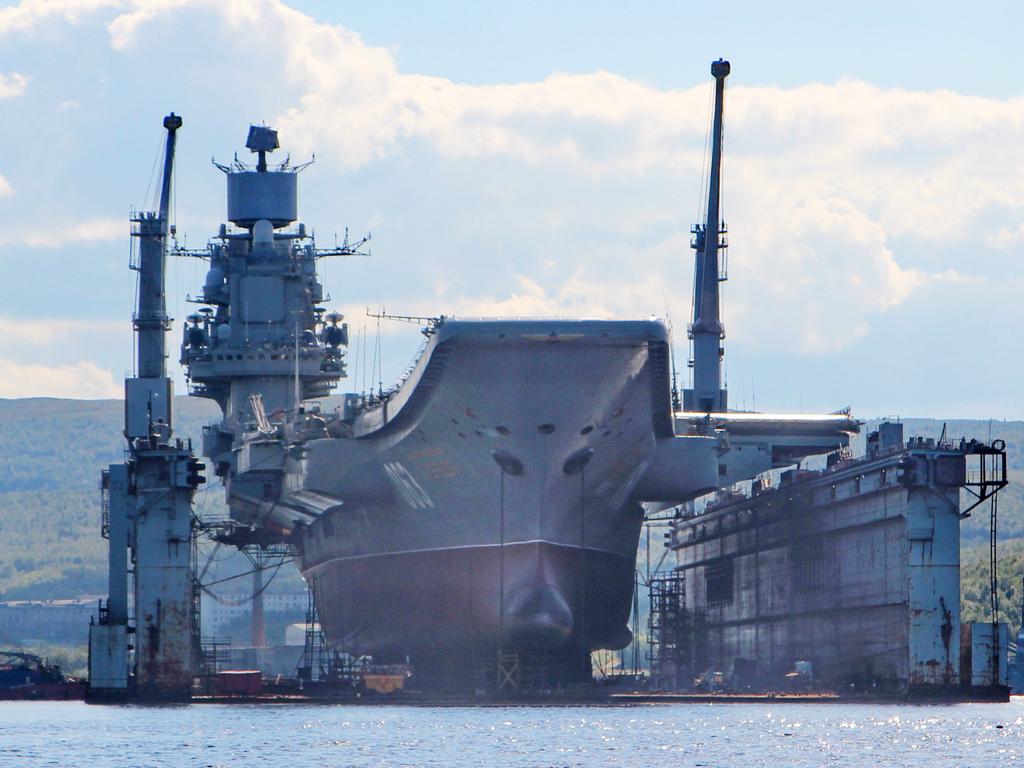Russian aircraft carrier damaged in dry dock accident
RUSSIA’S only aircraft carrier is not a lucky ship. Prone to fires and breakdowns, it’s now been damaged by a collapsing crane.

IT’s the pride of the Russian fleet. A pity it’s so accident prone. The Soviet-era aircraft carrier Admiral Kuznetsov has been undergoing a reconstruction to bring it up to date. But its floating dock just collapsed in on itself.
Russian media is reporting the 59,000 ton ship has had a 20 sqm hole ripped in its hull after a 70 ton crane lost balance as the floating dry dock it was attached to sank.
🇷🇺#Russian #Navy A collapsed cargo crane of floating dock on the flight deck of an RFS 063 ‘Admiral Kuznetsov’ aircraft carrier. Photo via @milinfolive pic.twitter.com/kooMEkItIQ
— Capt(N) (@Capt_Navy) October 30, 2018
Naval shipyard workers at the port of Murmansk were able to do little more than look on as the disaster unfolded before them. The port’s rescue authority reported 71 people had to be evacuated. One shipyard worker is missing and four others rushed to hospital — two of them in a critical condition.

DAMAGE ASSESSMENT
Russia’s Interfax news agency says the accident is being blamed on a power surge which caused the dock — designed to sink before rising again to lift a ship out of the water — to flood uncontrolledly. As the dock tilted and sank, stresses on two cranes caused them to buckle and collapse. One fell on the ship
Moscow has immediately stepped into damage control mode.
“The crane that fell left a hole 4 by 5 meters. But at the same time … these are structures that are repaired easily and quickly,” Alexei Rakhamnov, the head of Russia’s United Shipbuilding Corporation, told Russian media.

“Of course when a 70-tonne crane falls on deck, it will cause harm. But according to our initial information, the damage from the falling crane and from the ship listing when the dock sank is not substantial.”
It’s another story for the dock itself. Russian authorities are questioning if it can be salvaged.
“Even if this is technically possible, the operation will not be easy and, most probably, very expensive,” a spokesman for the shipyard said.

‘SHIP OF SHAME’
Kuznetsov earned a black name for itself as it billowed thick smoke on its way to the Mediterranean to assist Syria’s President Bashar al-Assad in 2016. Little wonder a tugboat would always be lurking near by.
As the ship passed through the English Channel, the UK’s then defence minister at the time, Michael Fallon, labelled the Kuznetsov the “ship of shame.”
RELATED: What we know about Russia’s new stealth fighter
Once it reached the eastern Mediterranean, two combat jets plunged into the sea on landing. The carrier abandoned flight operations, transferring its Su-33 and Mig-29 fighters to Russia’s air base in Syria.
After the failed deployment, Moscow ordered a dramatic rebuild of the warship to give it new engines, weapon systems, sensors, and the ability to operate heavy new Su-57 stealth fighters.
The unloading of turbo-pressurised boilers from aircraft carrier RFS 'Admiral Flota Sovetskogo Soyuza Kuznetsov'.Shipyard of 🇷🇺#Murmansk, #Russia. July 2018. Photo by ©花è½æˆèš€ pic.twitter.com/Sqos1VBNNZ
— Capt(N) (@Capt_Navy) July 22, 2018
That upgrade has since been dramatically scaled back under budget cuts, and the Su-57 seems unlikely to ever enter full production.
Kuznetsov, officially described as a heavy aircraft-carrying cruiser, was the only aircraft carrier fully completed during the Soviet era. It’s sister ship, Varyag, was left incomplete until sold to China. It was claimed it would be turned into a floating hotel, but ended up being commissioned as China’s first aircraft carrier — Liaoning.
RELATED: What we know about China’s new aircraft carriers
A Moscow Defense Ministry official says the accident won’t delay the aircraft carrier’s return to service in 2021. “At present, a detailed examination of the material part of the ship has been launched to identify possible damage. According to initial estimates, the ship did not receive any significant damage that could affect the timing of repairs.”



